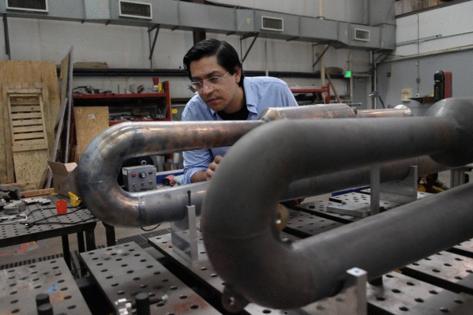From college lab to $73B market: Startup powers next wave of drones
Published in Science & Technology News
BALTIMORE — They deliver packages, inspect power lines, patrol remote areas, find missing people and increasingly are deployed on the battlefield.
Drones, including those used by consumers, businesses and the military, accounted for a $73 billion global industry last year, some estimates show, with the market likely to more than double by 2030.
Daanish Maqbool saw the potential of the booming drone industry while pursuing a doctorate in aerospace engineering at the University of Maryland. That’s when he began researching ways to improve propulsion systems for aircraft, including UAVs, or unmanned aerial vehicles. Engines had become one of the biggest bottlenecks in mass-producing certain aircraft.
Now heading North American Wave Engine Corp. in Baltimore, a company spun out of the university’s research in 2017, Maqbool and partners have an innovative fix that’s ready for market — jet engines with no moving parts. Products developed so far can power drones, but they will eventually propel general aviation aircraft as well.
The company designs and builds “wave engines,” which operate with pressure waves instead of rotating machinery. It has produced nearly 50 engines for customers, such as contractors for the federal government, but expects eventually to produce tens of thousands of units each year. One growth driver is expected to be the military use of drones that can intercept attack drones.
“There is a need for low-cost aircraft that can be produced in high volumes and can achieve high speeds,” said Maqbool, the company’s CEO. “Customers buying UAVs don’t want a few, very expensive things. They want very many cheap things. They’re looking for technologies that are lower cost.”
Instead of traditional jet engines with mechanical components, wave engines produce intermittent combustion, which produces pressure pulses that force air out of both ends of a tube, producing the thrust.
While turbine engines can be the most expensive and hard-to-source parts of aircraft, Wave Engine’s technology allows for high speeds and lower costs. Without moving parts, the engines don’t require the level of precision machining of traditional jet engines. They can be made from more readily available common materials, mostly stainless steel.
The company’s founders said no one else in the western hemisphere is working on similar wave engine technology. Such engines are under development, they believe, in Russia.
The company, with about seven full-time employees, raised about $1.5 million in 2018 in investments led by the Abell Foundation and the University System of Maryland’s Maryland Momentum Fund, then raised a second $3.5 million round.
In a warehouse on Canton’s industrial waterfront, headquarters since 2022, the company displays a series of prototype engines that show how designs have evolved since the university lab. They’ve moved from developmental to capable of being serially produced. They’re becoming progressively larger to handle heavier drones. A dozen patents have been awarded or are pending, said Andrew Geltman, the company’s chief administrative officer.
“Once you actually start flying these things, you also start learning about different challenges that you have in the air,” Maqbool said. Then, “when they go out to the customers and they start doing things with it, you learn things again. It’s always an evolution. We’re working on the next version.”
The company is also developing drones. Its latest model, the “Scitor-P, which features a top-mounted wave engine, had its first flights in May and the second on August 12. It will soon be launched as a drone product for the decoy and aerial target markets. The company has a pre-order from a customer that serves the Department of Defense.
The company has used its drone so far to test engines and as demonstrations for potential customers, including the DOD. In June, the Defense Department announced plans to boost production and fielding of drones.
Defense Secretary Pete Hegseth said in a memo in July that he’s rescinding policies that hindered drone production and plans to approve the purchase of American-made products for purchase by the military.
“Our adversaries collectively produce millions of cheap drones each year,” he said, while “U.S. units are not outfitted with the lethal small drones the modern battlefield requires.”
The idea for Wave Engine originated from the university’s department of aerospace engineering, where Maqbool and other researchers studied propulsion technology. He had grown up in Pakistan and attended the Massachusetts Institute of Technology as an undergraduate.
“These kinds of engines are mechanically very simple, but the underlying physics is complex, and there are still knowledge gaps in scientific circles,” he said. “Given that, it was very interesting as a research problem.”
It became clear that the technology could have compelling practical uses, particularly given the cost and manufacturing advantages.
“What you’re seeing is something that was a concept, an idea, and the evolution of the growth,” said Elizabeth Rhode, director of business development for the Baltimore Development Corp., the city’s economic development arm. “This is encouraging the next generation of future manufacturers in our city.
“They have the potential to continue growing and then hiring some of our local, up-and-coming generations to help with the future growth of unmanned aerial vehicles,” she said.
Defense applications have so far been most suitable for the current technology, Maqbool said.
“In the next versions, we are trying to get them to a level where commercial applications could possibly start to make sense,” he said, which means developing engines with less noise, greater efficiency and longer lifespans. “We’re going to have to continue to improve the technology to keep unlocking more markets.”
©2025 The Baltimore Sun. Visit at baltimoresun.com. Distributed by Tribune Content Agency, LLC.







Comments